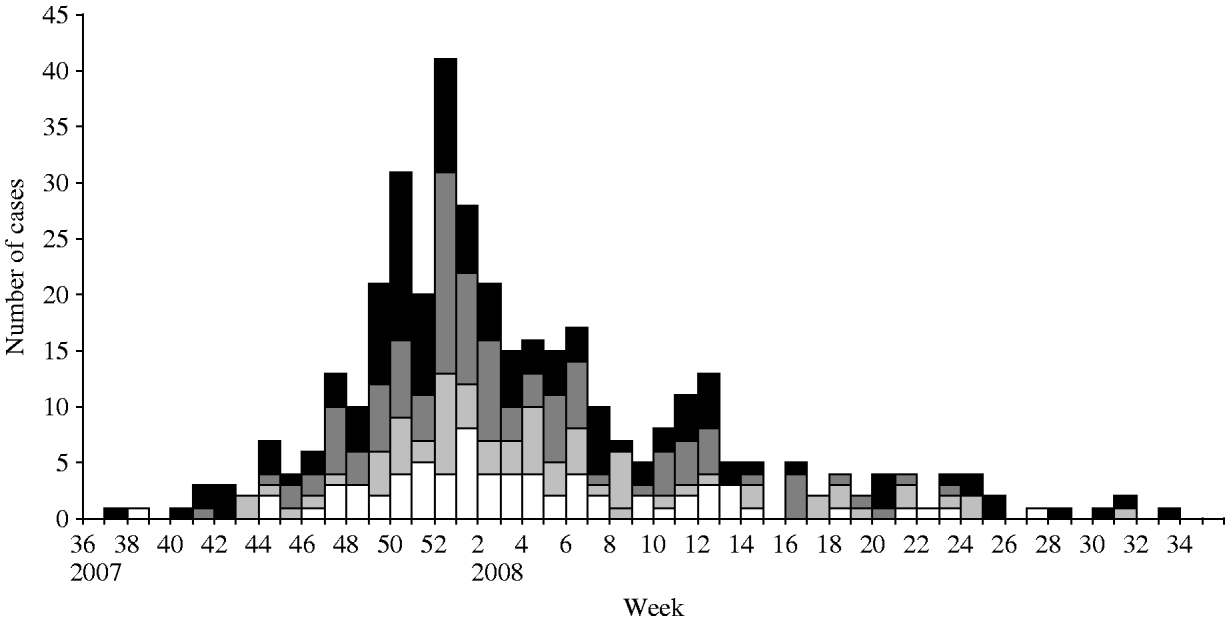Bronchiolitis is one of the leading causes of morbidity in infants aged <1 year and consumes substantial health-care resources [Reference Robinson1]. Due to the high number of cases and the often low severity of the disease, most studies have focused on the hospitalization rate in order to estimate the trends and the burden of the disease. Estimates of annual hospitalization rates in different populations ranged from 10 to 70/1000 children aged <1 year [Reference Lowther2, Reference Shay3] and most studies indicates a rise in annual hospitalization rates in recent decades [Reference Shay3–Reference Langley5]. A recent study found that 134·2 episodes of bronchiolitis/1000 person-years occurred during the first year of life with 17·1 hospitalizations/1000 person-years [Reference Koehoorn6].
In France, part of the surveillance of bronchiolitis in children is based on a pilot network of hospital emergency departments (OSCOUR®: Organisation de la Surveillance Coordonnée des Urgences) coordinated by the French national institute for public health surveillance (Institut de Veille Sanitaire; InVS). This network gathers data available in real time from hospital emergency departments [Reference Josseran7], including date of admission, age, sex, diagnosis (as defined during the emergency consultation using the 10th International Classification of Diseases), and evolution (discharge or hospitalization). Data are registered from patients' computerized medical files which are completed during the medical consultation and are transmitted automatically on a daily basis to InVS. There was no unique identifier for the patients who were seen in the emergency departments, so the number of children seen was probably slightly overestimated, because of children who were seen more than once during their episode of bronchiolitis.
For the purpose of this study, data from the Limousin region, where all the emergency departments participate to the network, were analysed during a 1-year period from 1 September 2007 to 31 August 2008. Limousin is a region in the centre of France with an estimated population of 724 998 inhabitants in 2006. Hospitalization per 1000 children was expressed as the number of bronchiolitis hospitalizations divided by the estimated number of children aged <1 year in the region provided by the national census (n=7292).
During the study period, 319 children aged <1 year consulted an emergency department for bronchiolitis (43·7/1000). The boy/girl sex ratio was 1·76 and more than one third (36·5%) of cases occurred in boys aged <6 months. The seasonal distribution according to age and sex is presented in Figure 1. One hundred and twenty-nine children aged <1 year were hospitalized following consultation; the hospitalization rate was 17·7/1000 children aged <1 year. The hospitalization rate was greater for boys than for girls (21·2/1000 vs. 14·1/1000, P=0·02), as previously documented [Reference Shay3].

Fig. 1. Number of cases of bronchiolitis presenting to the emergency department per week for children aged <1 year, according to age and sex, Limousin, France, 1 September 2007 to 31 August 2008. □, Girls ⩽6 months; ![]() , girls >6 months;
, girls >6 months; ![]() , boys ⩽6 months; ▪, boys >6 months.
, boys ⩽6 months; ▪, boys >6 months.
The characteristics of cases (age, sex, distribution over time) and the hospitalization rates in this study are consistent with other studies [Reference Koehoorn6, Reference Fjaerli, Farstad and Bratlid8]. This is despite different populations (in terms of country of origin, socio-economic status, age distribution), data collection methods and case definitions between studies. In France, a study has shown that about 7·5% of children aged <1 year who visited a general practitioner or a paediatrician for bronchiolitis, were directed to an emergency department [Reference Sebban, Grimprel and Bray9]. Elsewhere, often due to limited resources, many patients go directly to the emergency department where the consultations are free of charge (a previous study estimated that this concerns between 6·6% and 17·8% of the children) [Reference Stagnara10]. If we consider that 13–25% of the children aged <1 year with bronchiolitis need an emergency consultation (with or without hospitalization), we can estimate that the prevalence of bronchiolitis in children aged <1 year ranged between 17·7% and 34·4% in this region in 2007–2008. This result is much higher than that observed in a recent study [Reference Koehoorn6], but it should be interpreted taking into account the differences in primary-care organization and the varying sensitivity of surveillance systems across countries. Nevertheless, the estimated prevalence is quite similar to a previous analysis which estimated that one third of children aged <2 years are affected each year [Reference Grimprel11].
Although our analysis has some limitations (no data on disease history and lack of virological confirmation), we believe our surveillance based on emergency departments to be a valuable tool for large-scale estimating of the burden of a frequent illness such as bronchiolitis and its changes over time. It could be of particular interest to collect clinical information of patients (underlying condition, prematurity, previous respiratory syncytial virus infection) to better describe the risk factors associated with the occurrence of bronchiolitis. Nevertheless, the extension of such a surveillance to national level would allow an extensive monitoring and description of bronchiolitis. This would provide better estimates of the disease burden, its trends over time as well as contribute to assessing the impact of interventions.
DECLARATION OF INTEREST
None.



